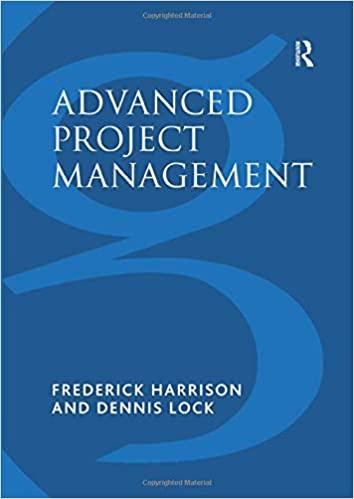| a.) As of December 31 (the end of the prior quarter), the company's general ledger showed the following account balances: CASH $48,000 (D) ACCOUNTS RECEIVABLE $206,400 (D) INVENTORY $58,950 (D) BUILDINGS AND EQUIPMENT (NET) $358,000 (D) ACCOUNTS PAYABLE $87,525 (C) COMMON STOCK $500,000 (C) RETAINED EARNINGS $83,825 (C) b.) Actual sales for December and budgeted sales for the next four months are as follows: DECEMBER (ACTUAL) $258,000 JANUARY $393,000 FEBRUARY $590,000 MARCH $304,000 APRIL $201,000 | | C.) Sales are 20% for cash and 80% on credit. All payments on credit sales are collected in the month following sale. The accounts receivable at December 31 are a result of December credit sales. | | | D.) The companys gross margin is 40% of sales. (In other words, cost of goods sold is 60% of sales.) | | | E.) Monthly expenses are budgeted as follows: salaries and wages, $23,000 per month: advertising, $63,000 per month; shipping, 5% of sales; other expenses, 3% of sales. Depreciation, including depreciation on new assets acquired during the quarter, will be $43,380 for the quarter. | | | F.) Each months ending inventory should equal 25% of the following months cost of goods sold. | | | G.) One-half of a months inventory purchases is paid for in the month of purchase; the other half is paid in the following month. | | | H.) During February, the company will purchase a new copy machine for $1,800 cash. During March, other equipment will be purchased for cash at a cost of $74,000. | | | I.) During January, the company will declare and pay $45,000 in cash dividends. | | | J.) Management wants to maintain a minimum cash balance of $30,000. The company has an agreement with a local bank that allows the company to borrow in increments of $1,000 at the beginning of each month. The interest rate on these loans is 1% per month and for simplicity we will assume that interest is not compounded. The company would, as far as it is able, repay the loan plus accumulated interest at the end of the quarter. REQUIRED: Using the data above, complete the following statements and schedules for the first quarter: 1. SCHEDULE OF EXPECTED CASH COLLECTIONS | | JANUARY | FEBRUARY | MARCH | QUARTER | | CASH SALES | $78,600 | | | | | CREDIT SALES | 206,400 | | | | | TOTAL COLLECTIONS | $285,000 | | | | 2. a.) Merchandise the purchases budget: MERCHANDISE PURCHASES BUDGET | | JANUARY | FEBRUARY | MARCH | QUARTER | | BUDGETED COGS | 235,800* | $354,000 | | | | ADD DESIRED END. INVENTORY | 88,500** | | | | | TOTAL NEEDS | 324,300 | | | | | LESS BEG. INVENTORY | 58,950 | | | | | REQUIRED PURCHASES | 265,350 | | | | | | | | | | *393,000 sales x 60% cost ratio = $235,800 ** 354,000 x 25% = $88,500 b.) Schedule of expected cash disbursements for merchandise purchases: SCHEDULE OF EXPECTED CASH DISBURSEMENTS FOR MERCHANDISE PURCHASES | | JANUARY | FEBRUARY | MARCH | QUARTER | | DEC. PURCHASES | 87,525 | | | | | JAN. PURCHASES | 132,675 | 132,675 | | | | FEB. PURCHASES | | | | | | MAR. PURCHASES | | | | | | TOTAL CASH DISBURSEMENTS FOR PURCHASES | | | | | 3. Cash budget (cash deficiency, repayments and interest should be indicated by a minus sign) HILLYARD COMPANY CASH BUDGET | | JANUARY | FEBRUARY | MARCH | QUARTER | | BEG. CASH BALANCE | 48,000 | | | | | ADD CASH COLLECTIONS | 285,000 | | | | | TOTAL CASH AVAILABLE | 333,000 | | | | | LESS CASH DISBURSEMENTS: | | | | | | PURCHASES OF INVENTORY | 220,200 | | | | | SELL & ADMIN EXPENSES | 117,440 | | | | | PURCHASES OF EQUIPMENT | | | | | | CASH DIVIDENDS | 45,000 | | | | | TOTAL CASH DISBURSEMENTS | 382,640 | | | | | EXCESS (DEFICIENCY) OF CASH | (49,640) | | | | | FINANCING: | | | | | | BORROWINGS | | | | | | REPAYMENTS | | | | | | INTEREST | | | | | | TOTAL FINANCING | | | | | | END. CASH BALANCE | | | | | 4. Prepare an absorption costing income statement for the quarter ending March 31. HILLYARD COMPANY INCOME STATEMENT QUARTER ENDING MARCH 31 | | | | | COST OF GOODS SOLD: | | | | | | | | | | | | | | | | | | | | | | | | SELL AND ADMIN EXPENSES: | | | | | | | | | | | | | | | | | | | | | | | | | | | | | | | | | | | | | | | | | | | 5. Prepare a balance sheet as of March 31. HILLYARD COMPANY BALANCE SHEET MARCH 31 ASSETS | CURRENT ASSETS: | | | | | | | | | | | | | | | | | | | | | | | | TOTAL CURRENT ASSETS | | | | | | | | TOTAL ASSETS | | | LIABILITIES AND STOCKHOLDER'S EQUITY | CURRENT LIABILITIES: | | | | | | | | | | | | STOCKHOLDER'S EQUITY | | | | | | | | | | | | | | | | | | | | TOTAL LIABILITIES AND STOCKHOLDER'S EQUITY | | | | | |






